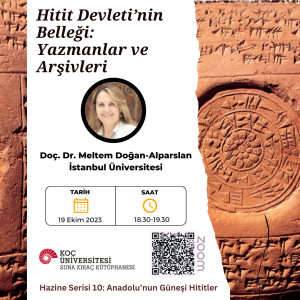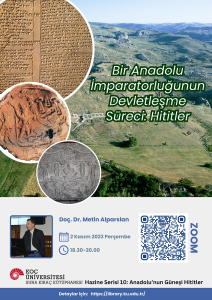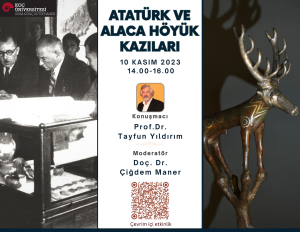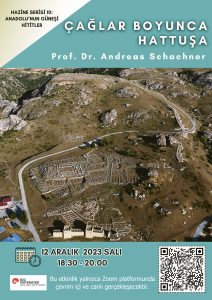The Sun of Anatolia: Hittites
About the Theme:
Suna Kıraç Library and its branch libraries aimed to bring together the Treasury Series collections and resources with researchers and interested people throughout September-December 2023. Within the scope of this project, the 10th theme of the Treasure Series was “The Sun of Anatolia: Hittites”.
The series, which was initiated with the inspiration of the library’s “Hatice Gonnet-Bağana Hittite Collection”, introduced the books, archive materials and printed collections in Koç University Libraries.
In this project, a team of three individuals collaborated to produce a comprehensive library subject guide. Additionally, three digital exhibitions were curated, spotlighting the language, religion, economy, architecture, and art of the Hittites. Furthermore, five conferences featuring prominent figures in the field were organized. Moreover, an insightful interview was conducted with Professor Dr. Hatice Gonnet-Bağana, our esteemed collection donor, delving into her profound journey in Hittite history and Hittitology.
Project Team:
- İlknur Erkin (KUH Health Sciences Library)
- Rana Otur (Suna Kıraç Library)
- Dr. Remziye Boyraz Seyhan (AKMED Library)
Conference – 1
Memory of the Hittite State: Scribes and Archives (Assoc. Prof. Dr. Meltem doğan-Alparslan)
The inaugural session of the conference series, organized under the theme “Treasure Series 10: The Sun of Anatolia, Hittites,” featured a presentation by Meltem Doğan-Alparslan entitled “Memory of the Hittite State: Clerks and Archives.” This session occurred on Thursday, October 19th, and the recording of the event was subsequently made available on the Suna Kıraç Library’s YouTube channel.

Conference – 2
“The Nationalization Process of an Anatolian Empire: Hittites” (Assoc. Prof. Dr. Metin Alparslan)
The conference entitled “The Nationalization Process of an Anatolian Empire: Hittites” was presented by Metin Alparslan, renowned for his contributions to Hittitology. It was conducted on November 2, 2023. The recording of the conference was subsequently made available on the Suna Kıraç Library’s YouTube channel.

Conference – 3
“Atatürk and Alacahöyük Excavations” (Prof. Dr. Tayfun Yıldırım)
Alaca Höyük Excavations, which started in 1935 with the directives of Mustafa Kemal Atatürk, have a special importance for Anatolian archeology as it is the first scientific excavation to represent the Republic of Turkey at the international level. The 3rd conference of the Treasure Series, presented by Tayfun Yıldırım, who has been the Head of Alaca Höyük Excavations since 2020, took place on 10 November 2023 with the title “Atatürk and Alaca Höyük Excavations”. The recording of the event was subsequently made available on YouTube Suna Kıraç Library channel.

Conference – 4
“Hattusa Through the Ages” (Prof. Dr. Andreas Schachner)
Andreas Schachner, who headed the excavations on behalf of the German Archaeological Institute, was our guest on December 12, 2023 with his conference titled “Hattusa Through the Ages”. The speech highlighted the significant and remarkable findings of the excavations in Hattuša, drawing attention to the importance of the city in Hittite history. The event was held exclusively online.

Conference – 5
“The First Indo-European Language Speakers in Anatolia: From Het Sons to Hittites” (Prof. Dr. Hasan Peker)
In this conference, which focused on the Hittites who spoke the first Indo-European languages in Anatolia, the languages spoken in Anatolia and linguistic diversity were touched upon. The event was held exclusively online.on December 27, 2023.

Exhibitions prepared by students of Koç University Department of Archeology and Art History, with images selected from the Hatice Gonnet-Bağana Hittite Collection, are available on the library “Digital Collection” page.
Digital Exhibiton: Living Stories of The Hittites – Prepared by: Damla DALGIÇ (Click to go to the exhibition)
Digital Exhibiton: Neo-Hittite City States – Prepared by: Ufuk ÖNAY (Click to go to the exhibition)
Digital Exhibiton: The Fortress Azatiwatas: Karatepe-Aslantaş – Prepared by: Zeynep Hilal SERİ (Click to go to the exhibition)
In the subject guide, the books, archive materials and printed collections in Koç University Libraries are introduced, based on the library’s “Hatice Gonnet-Bağana Hittite Collection”, and fundamental informations about Hittite history and sources. All activities are also included in the guide.
You can access our subject guide here.
1- Sun of Anatolia Hittite Theme Introduction (September 4, 2023)
Suna Kıraç Library Treasure Series 10: The new theme “Hittites, the Sun of Anatolia” will continue throughout September – December. B.C. The focus will be on the Hittites, who established the first political union in Anatolia in 1750. Inspired by the “Suna Kıraç Library Hatice Gonnet-Bağana Hittite Collection”, we will get to know the language, religion, economy, architectural, and artistic remains of the Hittites and shed light on the history of Anatolia.
You can access the detailed version of the post here.
2- “Sun of Anatolia: Hittites” Subject Guide (September 15, 2023)
Suna Kıraç Library Treasure Series 10: A library guide within the scope of the theme “Sun of Anatolia: Hittites”, presents you with fundamental information and sources about Hittite history. You can also follow all related events and social media posts through this guide.
You can access the detailed version of the post here.
3- Hatice Gonnet-Bağana Hittite Collection (September 15, 2023)
Hittitologist/Archaeologist Hatice Gonnet Bağana donated her archive covering the years 1960-2000 to Koç University Suna Kıraç Library in 2014. The collection, which was digitized by the Suna Kıraç Library, and was opened to access in September 2015.
You can access the detailed version of the post here.
4- Hatti Sun Disk, Alacahöyük (18 September 2023)
The sun disk recovered from royal tombs consists of elements arranged around a circular shape symbolizing the sun. In some examples, there are pieces that swing to make sounds, the image of a deer symbolizing peace, and as well as bird and tree figures to symbolize reproduction. It was affixed to the ends of wooden staffs and employed as a standard or banner in religious ceremonies or processions. Currently, it is exhibited at the Anatolian Civilizations Museum.
You can access the detailed version of the post here.
5- Lion Gate, Hattusa, 14th Century BC (22 September 2023)
Located in the southwest of Hattusa (Boğazköy), the capital of the Hittite Empire, the Lion Gate continued its existence starting from the 17th century BC until the collapse of the empire in the early 12th century BC. In the 12th century BC, the city covered an area of 182 hectares and was surrounded by a 3.3 km long city wall. The Lion Gate was decorated with two lion statues. It was believed that lions protected the city from evil spirits.
You can access the detailed version of the post here.
6- “Apamea” Stele Inscription (25 September 2023)
The “Apamea” stele inscription displayed at the Aleppo Museum, is situated on one of the few large blocks in Hama (Apamea), dating back to the 9th century BC. These blocks attributed to the era of Hittite rule, which shifted to Hama (formerly known as Hamath) following the Syrian campaign of the Hittite ruler Suppiluliuma. The Luwian hieroglyphic inscription on this stele holds significant scholarly value as an important historical document.
You can access the detailed version of the post here.
7- Maraş Stele, 7th Century BC (29 September 2023)
This drawing by Hatice Gonnet-Bağana represents the figure depicted on the Maraş Stele. The funerary stele portrays a young man holding two scales, one open and the other closed in his right hand. It is thought that the figure is a person producing scales. 7th century BC. Dating back to the 7th century BC, the Maraş Stele is housed in the Louvre Museum in Paris.
You can access the detailed version of the post here.
8- A Relief and a Lion on a Portal in Sakçagözü, Postcard (3 October 2023)
There is Hatice Gonnet-Bağana’s handwriting and notes on the reverse of the postcard (No. Ankara 10113) showing a relief and a lion on a gate in Sakçagözü, exhibited in the Ankara Archeology Museum.
You can access the detailed version of the post here.
9- Alacahöyük, A King and a Queen, in front of an Altar and the Bull of the Storm God (6 October 2023)
In the relief discovered at the sphinx city gate, a king and a queen are depicted worshiping the Huwasi stone and the bull representing the Sky/Storm god.
Alacahöyük is a significant Hittite city situated 36 km northeast of Hattusa (Boğazköy). Despite its importance during the pre-Hittite period, it was overshadowed following the establishment of Hattusa.
You can access the detailed version of the post here.
10- Alacahöyük, Relief Near the Gate of Apollo, 14th Century BC (13 October 2023)
It is a relief found near the Sphinx Gate in Alacahöyük, dating back to the Hatti Period and depicting the procession of statesmen. Although Alacahöyük has been an important settlement since prehistoric times, it remained in the shadow of the capital after the establishment of Hattusa (Boğazköy). Although the artifacts unearthed in the Hatti king tombs dating back to around 2500 BC in Alacahöyük, located approximately 36 km northeast of Hattusa in Turkey’s Çorum province, constitute the most important findings, the most impressive monuments today belong to the Hittite Period.
You can access the detailed version of the post here.
11- Rock Reliefs, Yazılıkaya, Section A (16 October 2023)
For the Hittites, Yazılıkaya held significant religious importance and was situated approximately 2 km northeast of Hattusa, the capital of the Hittite Empire. It acquired a monumental character through the addition of structures erected in front of a natural rock formation that had been utilized for rituals since the 3rd millennium BC. The reliefs adorning the important chambers of this open-air temple depict the gods of the Hittite pantheon from the 13th century BC.
You can access the detailed version of the post here.
12- Yazılıkaya Sanctuary, Hattusa (20 October 2023)
Yazılıkaya was a sacred site located in present-day Çorum province of Turkey, approximately 1.5 km northeast of Hattusa, the capital of the Hittite Empire. This site was a sacred place for the Hittites and was conveniently located within walking distance of the city gates. It is probable that Yazılıkaya may have served as a sacred place for New Year’s celebrations and ceremonies in the spring. Comprising two open-air rooms surrounded by natural rock formations, the sanctuary was not covered. This sanctuary has been used since at least the late 16th century BC, but the majority of the rock reliefs date back to the reign of Hittite kings Tudhaliya IV and Suppiluliuma II in the late 13th century BC.
You can access the detailed version of the post here.
13- Relief of the Sun God (Tuthaliya IV in priestly clothing?) Holding the Winged Sun Disc, Yazılıkaya Section A (23 October 2023)
The winged sun disk was associated with divinity, royalty and power.
You can access the detailed version of the post here.
14- Relief Depicting Suppiluliuma I, Hattusa (27 October 2023)
This stele is carved into the wall at the end of the Boğazköy Güneykale tunnel. It depicts the Hittite King Suppiluliuma I, was known as a great warrior and statesman, who reigned between 1344-1322 BC. The relief, originally used as a tombstone, was later brought to the tunnel by his successor, by Suppiluliuma II, for placement here.
You can access the detailed version of the post here.
15- Rock Throne, Harpatu Monument, Kızıldağ (30 October 2023)
View of the plateau and lake near the rock throne in Kızıldağ, near Karaman province. In addition to the “Throne” relief, an inscription situated near the mountain’s summit has been unearthed. The relief carved onto the flattened surface of the throne’s backrest depicts a seated figure holding a scepter in his left hand and a vessel in his right hand. and the Luwian hieroglyphic inscription located right next to the head of the figure reads “Great King, Hartapu”. Hartapu, mentioned in two other Hittite monuments at Karadağ and Burunkaya, was probably the name of one of the local rulers who received such traditional titles after the collapse of the Hittite Empire. The monument, which seems to date to the early period due to its inscription style, is thought to date to the 8th century BC or much later due to the relief of the king.
You can access the detailed version of the post here.
16- Relief D: King (PUGNUS-mili) making an offering and sacrifice to the Storm God (6 November 2023)
The King (PUGNUS-mili), King of Sulumeli, makes an offering to the gods. This limestone relief is part of the Lion’s Gate. Although it is dated to the 9th century BC according to some researchers, it may also indicate an earlier date. The relief is currently on display at the Anatolian Civilizations Museum in Ankara, with the inventory number 12253.
You can access the detailed version of the post here.
17- Malatya, Lion Hunt Scene, Basalt Relief (9 November 2023)
It is a relief of male figures chasing a lion, found in Aslantepe near Malatya. The relief, which probably dates back to 1000-850 BC, is on display at the Ankara Anatolian Civilizations Museum.
You can access the detailed version of the post here.
18- City Gate Orthostat Relief, Offering to the Gods, Late-Hittite Style, Arslantepe, Malatya (13 November 2023)
Relief with hieroglyphic Luwian inscriptions on it, unearthed near Arslantepe (Lion Hill) in Malatya. King Sulumeli offers sacrificial blood to the gods. Behind the king, in the lower right corner, is a servant restraining a bull that will probably soon be sacrificed. The Storm God is depicted twice: on the left, riding in his chariot; while accepting the king’s offering in the middle. In the lower right corner, a servant is seen restraining a bull that will probably be sacrificed soon. Hieroglyphic Luwian inscriptions provide some clues about the figures depicted. Basalt was used as the material, and the Late-Hittite reliefs made in traditional style date back to the 10th-9th centuries BC.
You can access the detailed version of the post here.
19- Tuwarsa Relief, Carchemish (23 November 2023)
The basalt relief depicts a queen (or a court official) embracing her youngest son, Tuwarsa, and possibly guiding a goat. The inscription records that “the ruler’s favorite(?) and the prince whose distinction was declared” (Hawkins 2000: 129). This relief, which can be dated to the 9th century BC, is among the orthostats of the building known as the King’s Bastion. The King’s Bastion was built later next to the entrance of the procession and these reliefs were discovered in situ. It is exhibited at the Anatolian Civilizations Museum in Ankara.
You can access the detailed version of the post here.
20- Katuwa Hieroglyph, Carchemish, 9th century BC (24 November 2023)
King Katuwa is depicted on the basalt stele. There is a nine-line Luwian inscription describing the offerings made to the gods by Katuwa. The stele, which is currently exhibited at the Museum of Anatolian Civilizations, was unearthed in Carchemish.
You can access the detailed version of the post here.
21- North gate, West Wall Relief, a Male Figure Carrying a Sacrifice on His Shoulder (27 November 2023)
The relief depicts a male figure carrying a deer after hunting. It is among the reliefs showing cultural, mythological, and daily life scenes in the Late Hittite fortress at Karatepe (also known as Aslantaş, located in Osmaniye-Adana province). These reliefs are engraved on basalt blocks. The area was first discovered by Helmut Bossert and Halet Çambel in 1946. The fortress was founded in the 8th century BC by Azatiwata, the ruler of the Adanawa. The hieroglyphs were inscribed in both Phoenician and Aramaic languages.
You can access the detailed version of the post here.
22- Karatepe, Sphinx gate at the Northern Gate (December 1, 2023)
Karatepe can be seen with the ruins of the Late Hittite fortress built in Osmaniye province and Kadirli district. This fortress was founded in the 8th century BC by Azatiwata, the ruler of the Adanawa, as a border fortress in the north and named Azatiwataya.
You can access the detailed version of the post here.
23- Suhi’s Wife, Carchemish A 1 b, Compared Text (4 December 2023)
The seated female figure depicted is identified as Suhi’s (II) wife. It also includes the notes of Hatice Gonnet-Bağana and the transliteration of the Luwian inscription into the Latin alphabet. Carchemish is an ancient city-state located in southern Turkey, on the Syrian border, on the west bank of the Euphrates River, near the modern town of Jarābulus in northern Syria, and southeast of Gaziantep. It is the strategic crossing point of the Euphrates River for Syria, Mesopotamia and Anatolia trade and came under the dominion of various powers, including the Mitanni, Hittite, and Neo-Assyrian Empires.
You can access the detailed version of the post here.
24- King Warpalawas, Detail from Ivriz Relief (8 December 2024)
İvriz Monument is located near the village of Ivriz, approximately 12 km away from Konya. This substantial relief, measuring approximately 4.20 m in height and 2.40 m in width, is carved into the rock near a large spring. The relief depicts a scene in which King Warpalawas of Tuwana offers his respect and expresses gratitude to Tarhunzas, the God of Fertility, who carries ears of wheat in one hand and bunches of grapes in the other, with both hands clenched into fists.
You can access the detailed version of the post here.
25- Late-Hittite Period Relief Orthostat, Karatepe North Gate (12 December 2023)
It is a relief discovered in the Late Hittite fortress Karatepe (also known as Aslantaş) in Osmaniye province. This area was first discovered by Helmut Bossert and Halet Çambel in 1946. The castle was built by Azatiwata, the local ruler of the Adanawa, in the 8th century BC. Two huge T-shaped gate towers, surrounded by high towers, provided entrance to the castle. Orthostat reliefs made of basalt stone decorated the doors and entrance structures.
You can access the detailed version of the post here.
26- South Gate of Karatepe – Relief Depicting a Banquet Scene on the Eastern Wall (18 December 2023)
The scene depicts the king seated at a banquet accompanied by musicians playing lyres and other stringed instruments; there are also drum-like and flute-like instruments and attendants, with this section focusing more on the attendants bringing food to the feast. The area was initially discovered by Helmut Bossert and Halet Çambel in 1946. The fortress was established in the 8th century BC by Azatiwata, the ruler of the Adana plain.
You can access the detailed version of the post here.
27- Basalt Relief, “Children of King Araras, (21 December 2023)
King Araras’ children are playing with knucklebones and spinning tops. Both children’s games have continued to exist until today. The relief, dating back to the 8th century BC, is exhibited at the Anatolian Civilizations Museum.
You can access the detailed version of the post here.
